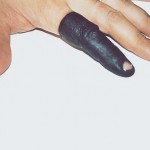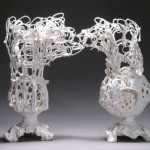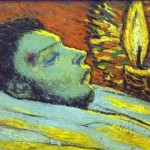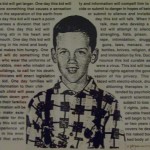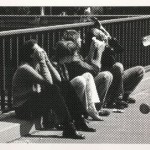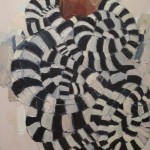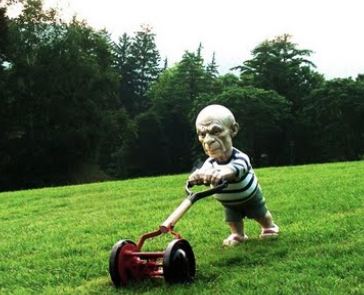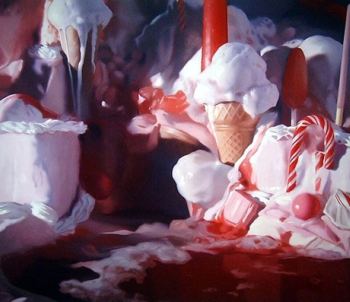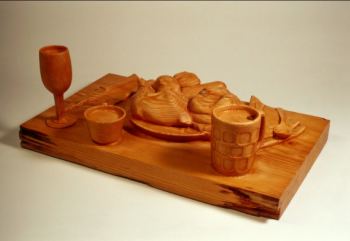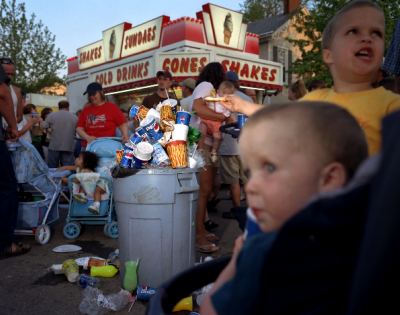I need to get a computer checkup, as the text begins to erase itself as I type. Maybe it’s my longed-for editor in disguise. Back soon.
Main Content
Carrie E. A. Scott – back to Seattle without leaving New York
(Photo, Art in America)
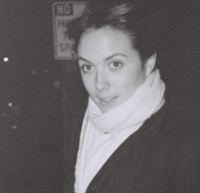 Carrie E. A. Scott is the new (and first) East Coast director for Seattle gallery Ambach & Rice, owned by Amanda and Charlie Kitchings.
Carrie E. A. Scott is the new (and first) East Coast director for Seattle gallery Ambach & Rice, owned by Amanda and Charlie Kitchings.
Since May 2008 and ending recently, she was director at Nicole Klagsbrun in New York. Before that, she was director at James Harris and ran the nonprofit space known as the Hedreen Gallery.
Each month she plans to spend a week in Seattle and three in New York.
Scott:
I’ll be doing everything a director does – curate and coordinate with clients and artists. Amanda and Charlie want to help build a bridge between the coasts that includes the Northwest. The gallery will continue to bring East Coast artists to Seattle, and I’m planning exhibits in New York that will help bring attention to some artists who deserve to be part of a larger discussion. While at Nicole Klagsburn I introduced Storm Tharp, and the Whitney bought a drawing. I’m looking to do more of that. We won’t have our own space in New York but will find temporary quarters.
When do you start?
Now. I’ve started.
Any shows in the works?
None I can talk about yet. Soon.
Art and cupcakes: cough up the artist’s names
The opening of Cupcake Royale on Capitol Hill earned ecstatic notices from Seattle art bloggers, some of whom are personally involved.
Joey Veltkamp of Best Of will serve as art curator after the first show, curated by Roy McMakin, who with Ian Butcher (both from Domestic Architecture) designed the space. (Check the Best Of link for artists now on view.)
Not only is the place lovely, it features seriously good art perched in various nooks and crannies. If you want to know who did what, however, you have to follow the corridor to the bathrooms to find the credits.
Museums and (more frequently) galleries tuck identifying labels into obscure locations (or print maps available at the front desk) when they don’t want to disturb the pristine experience of viewing the art. But this is a cupcake shop. There is no pristine experience. Put the artist’s names and title beside the art. Hiding the who/what/when is pretentious beyond belief.
Picasso’s summer job
Eating used to be a good thing
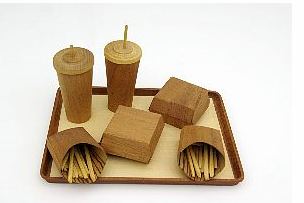
William Carlos Williams, This Is Just To Say
I have eaten
the plums
that were in
the icebox
and which
you were probably
saving
for breakfast.
Forgive me
they were delicious
so sweet
and so cold.
Eric Yahnker: Ludicrious Cubism (A dog walks into a bar)
Doggie-style perspective isn’t above a grade-school joke. The myopic have four eyes. (4-Eyed Dog, Pencil on paper)
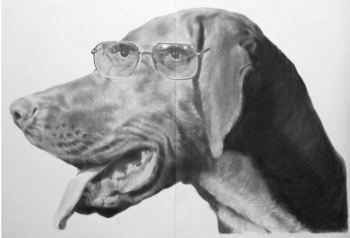 Currently at Ambach & Rice, Eric Yahnker draws as if the camera hadn’t been invented and he’s the unreliable narrator assigned to keep a record. Exactitude is his straight man. He renders tongue, teeth, slack lip, the golden shine on the short hair to set up the punchline.
Currently at Ambach & Rice, Eric Yahnker draws as if the camera hadn’t been invented and he’s the unreliable narrator assigned to keep a record. Exactitude is his straight man. He renders tongue, teeth, slack lip, the golden shine on the short hair to set up the punchline.
Another artist who drew this well would stick to drawings, but Yahnker has the nervous energy of a comic on stage. Visual jokes tumble from him. Part of the joke is their production: Serious craftsmanship is essential to being absurd and saves him from the trap of visual one-liners.
Dorothy’s trip to bright lights, green city exposed a sham. If she’d read a little Existentialism, would she have bothered to go? Online, the drawing itself is hard to see, but in person, pencil on paper orchestras a drama – soft light pools across the top of her head as shadows curl around her fingers and deepen into the nape of her neck.
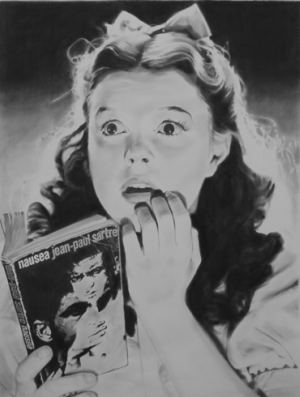 Robert Smithson’s Mirror Displacement is the source of Yahnker’s Analogous To The Fall Of That One Empire (Moby Dick); roughly a million cut-out and alphabetized letters from Moby Dick on 27 mirrored panels (26 for the letters in the alphabet and one more for punctuation).
Robert Smithson’s Mirror Displacement is the source of Yahnker’s Analogous To The Fall Of That One Empire (Moby Dick); roughly a million cut-out and alphabetized letters from Moby Dick on 27 mirrored panels (26 for the letters in the alphabet and one more for punctuation).
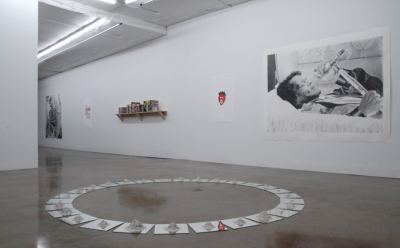 It’s also a tribute to Andy Kaufman, who read The Great Gatsby on stage.(here on YouTube). What to do with a masterpiece? Scholars who analyze cut it up, while cut ups like Yahnker take the process to its literal (and fatal) end.
It’s also a tribute to Andy Kaufman, who read The Great Gatsby on stage.(here on YouTube). What to do with a masterpiece? Scholars who analyze cut it up, while cut ups like Yahnker take the process to its literal (and fatal) end.
Less Than Zero to 101 is a shelf full of CDs cassette tapes, LP’s, books and magazines whose titles number in order from <0 to 101. Less Than Zero, Absolute Zero, The Beatles 1, Two Dads, 2 1/2 Men, Three Amigos! Four Brothers….7th Heaven, 7th Season, …12 Monkeys…18-Year-Old Virgin, 26 Gasoline Stations…36 Hours to Die…Around the World in 80 Days to 101 Dalmatians.
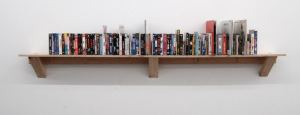 Detail:
Detail: 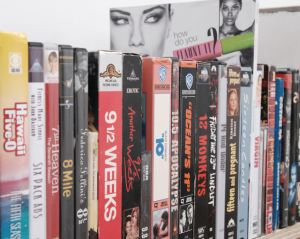 Yahnker is a maker run deliberately amuck. His methods are rigorous, and his results absurd but not frivolous.
Yahnker is a maker run deliberately amuck. His methods are rigorous, and his results absurd but not frivolous.
Analogous To The Fall Of That One Empire (Gap Shirt), shirt in which all of the thread has been removed excluding the pinstripe pattern:
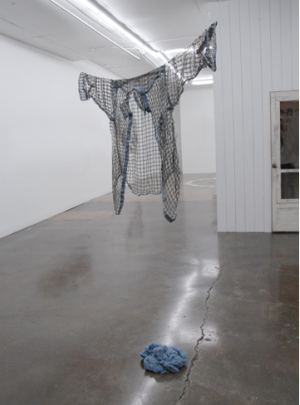 Drew Daly did something similar with chairs: Whittling away a sturdy one to produce a pair of barely-there ghosts.Yahnker began unthreading the shirt after Bush was elected for the second time, in 2004. The empire that fell is our own.
Drew Daly did something similar with chairs: Whittling away a sturdy one to produce a pair of barely-there ghosts.Yahnker began unthreading the shirt after Bush was elected for the second time, in 2004. The empire that fell is our own.
Bradd Skubinna – gardens of plastic delights
Somewhere between Polly Apfelbaum and Pae White is Bradd Skubinna at Francine Seders, with maybe a dog’s left jog over to Richard (Dick) Elliott, whose murals are made of bicycle reflectors.
(Photos Spike Mafford)
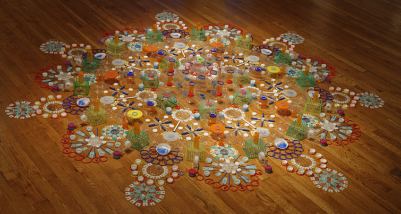
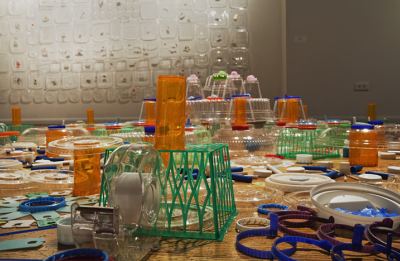 On the floor, Skubinna’s starburst pattern of plastic discards, Gabe Liked Jazz, radiates outward from a meticulously color-coded center. Plastic trays for apples, small appliances, meals to go, light bulbs and muffins inflect a wall with ripples of translucent patterns accented with the remains of torn labeling. A blue screen made of blue New York Times‘ bag wrappers torn to let the light through hangs in the middle of the gallery. Both indoor sky and plastic lace, it sways faintly when the front door opens.
On the floor, Skubinna’s starburst pattern of plastic discards, Gabe Liked Jazz, radiates outward from a meticulously color-coded center. Plastic trays for apples, small appliances, meals to go, light bulbs and muffins inflect a wall with ripples of translucent patterns accented with the remains of torn labeling. A blue screen made of blue New York Times‘ bag wrappers torn to let the light through hangs in the middle of the gallery. Both indoor sky and plastic lace, it sways faintly when the front door opens.
Northwest Film Forum wants $10
The Northwest Film Forum is a one-stop shop for the Seattle’s cultural life, a hub that draws from visual art, theater, dance and music communities, recognizing the fluid reality of contemporary art.
With a 30 percent drop in income, however, the forum needs help if it is to continue its programming at present levels, not only the film programming but the summer filmmaking camps for kids, screenwriting and film editing classes, filmmakers brought to town and the movies it is instrumental in getting made.
Director Lyall Bush is asking anybody with a stake in the forum to send a $10 donation by Aug. 15:
Please walk
it in, mail
it in, or click here to make your donation.
Birds in art (the enmity of crows)
There’s a crow in my neighborhood who wants me dead. Its screams when it sees me are heart-stopping. Do I look like someone who kicked a chick?
I watched Alfred Hitchcock’s The Birds with a niece intent on seeing the classics. I wouldn’t have picked that one, but when the hapless human herd is strafed by birds, I thought of one whose venom might be keeping it up nights.
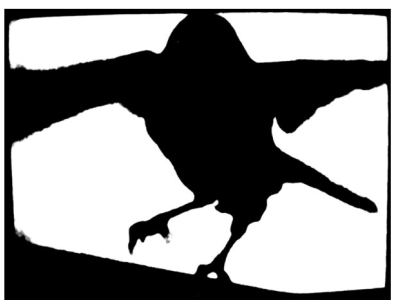 Jean-Luc Mylayne takes an entirely different view, offering a fusion of factual clarity and high romance.
Jean-Luc Mylayne takes an entirely different view, offering a fusion of factual clarity and high romance.
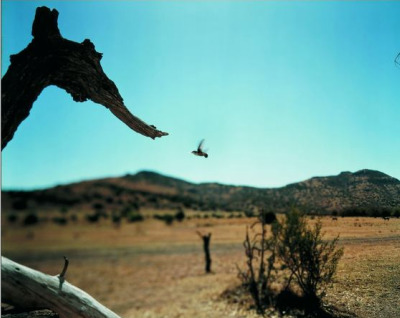 Jessie Henson liberates hers from embroidery.
Jessie Henson liberates hers from embroidery.
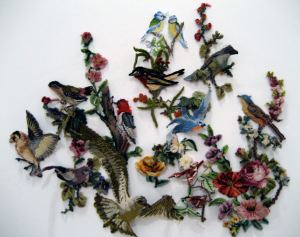 Facts aren’t enough for Justin Gibbens.
Facts aren’t enough for Justin Gibbens.
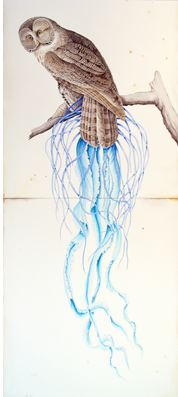 Elizabeth Sandvig is drawn to the avian world of improbable collaborations.
Elizabeth Sandvig is drawn to the avian world of improbable collaborations.
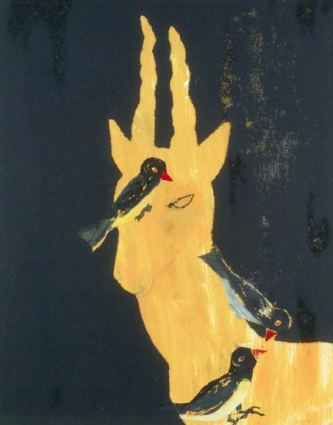 Mike Simi takes his birds past Bladerunner, into the realm of ordinary plastics.
Mike Simi takes his birds past Bladerunner, into the realm of ordinary plastics.
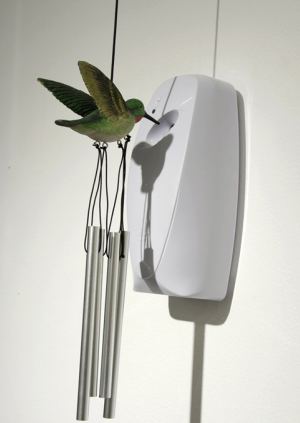 Michael Spafford ‘s have mystical powers.
Michael Spafford ‘s have mystical powers.
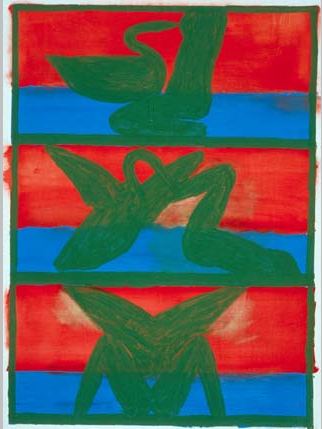 Anselm Kiefer‘s have read too much and forgotten how to fly.
Anselm Kiefer‘s have read too much and forgotten how to fly.
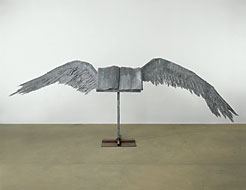 Mine hops up and down on the branches of a high tree. Once earned, the enmity of crows deepens and grows.
Mine hops up and down on the branches of a high tree. Once earned, the enmity of crows deepens and grows.
Seattle gallery introductions: Let me present my wife
Last fall, members of the Seattle Art Dealers Association (SADA) attempted to define who in their view is a singular artist for an exhibit titled, Century 21: Dealer’s Choice.
Predictably, the results were mixed. Just because dealers align themselves in a group doesn’t mean they have
anything in common. Like every other city with a thriving gallery
scene, Seattle’s galleries run on different tracks. Many specialize in
intimate home decor. As long as there is a market for art that contains
no criticality in its approach to content, there will be galleries to
provide it.
This summer, perhaps smarting from criticism about being out of touch, SADA is back with a second project. Each gallery picked somebody new. Setting aside the fact that summer is frequently a time for introductions, what are the results?
Richard Thurston of the Grover/Thurston Gallery picked his wife, Marianne Pulfer.
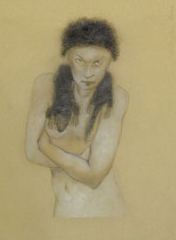 Thurston:
Thurston:
It’s my gallery. I can do what I want.
He means of course that it’s his and Susan Grover’s gallery. Considering that Grover is his ex-wife, Thurston gets credit for his sterling sense of family values. Picking his wife is an expression of his up-yours attitude toward his peers. Plus, Pulfer is a step up for the gallery, fiercer and more compelling than much of its usual fare.
The other surprise came from Foster/White Gallery. With the photographs of Cara Barer, Foster/White moved decisively away from the visual niceties it too frequently features. Her images of ravaged books remind me of the Laura Dean Dancers in the 1970s and ’80s.
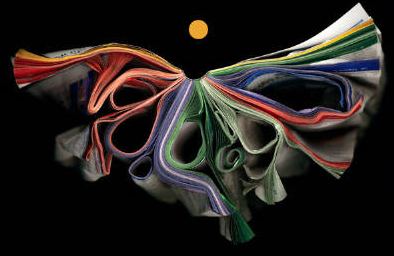 Other strong intros: Brent Sommerhauser at Greg Kucera; David Huffman at James Harris; Michael Bryon at Howard House; Ariana Page Russell at Platform, and Mark Kang O’Higgins at Linda Hodges for one painting, Deposition.
Other strong intros: Brent Sommerhauser at Greg Kucera; David Huffman at James Harris; Michael Bryon at Howard House; Ariana Page Russell at Platform, and Mark Kang O’Higgins at Linda Hodges for one painting, Deposition.



